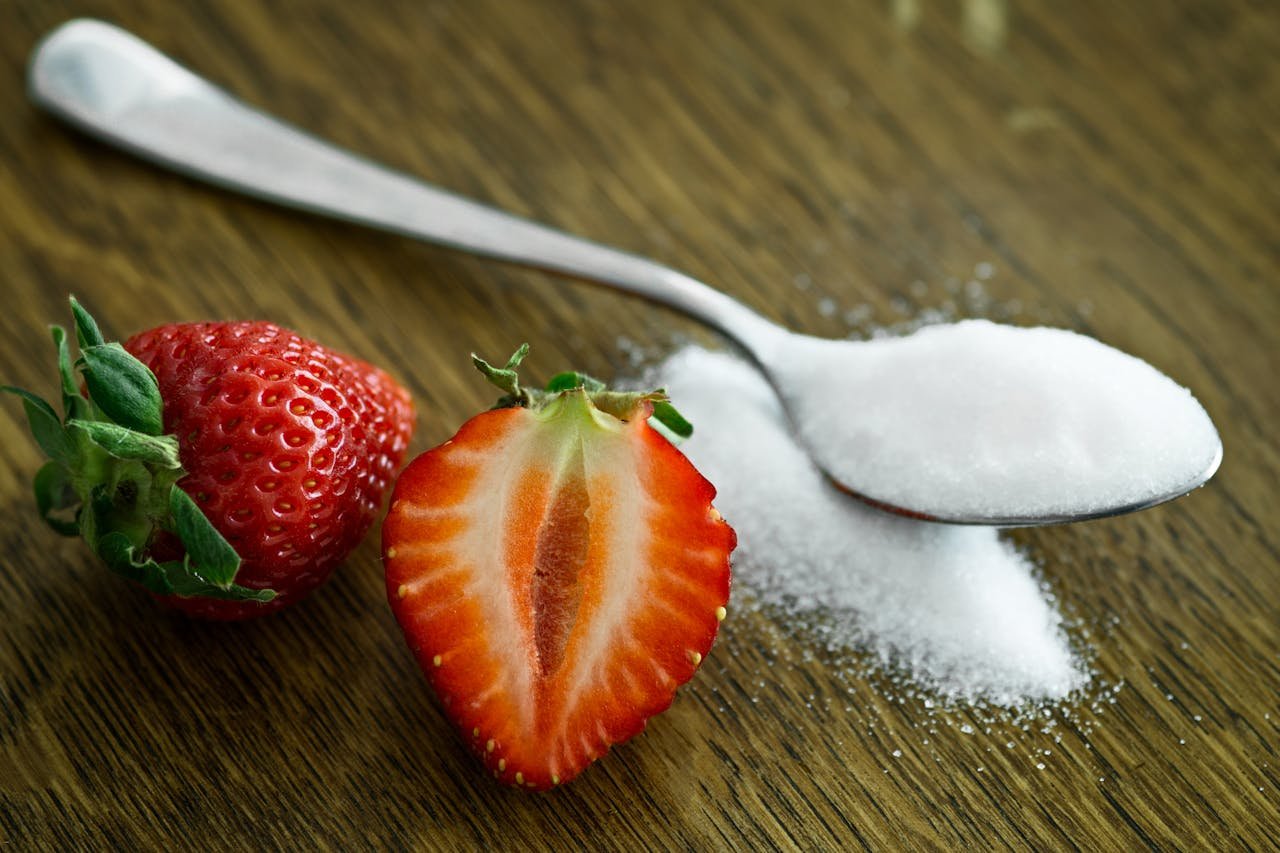It is important to limit sugar consumption, as it is vital to controlling diabetes or prediabetes and living a heart-healthy lifestyle. Excess added sugar, which is present in cakes, sweets, soda, and chocolates, results in the intake of extra calories, leading to obesity and a sudden increase in blood sugar levels.
The good news? You don’t have to radically alter your lifestyle to notice significant changes in your overall well-being. In this post, we’ll share some adjustments you can make in your daily diet to reduce sugar intake while still savouring tasty foods and eliminating thousands of calories.
What Is Sugar?
Sugar is a type of carbohydrate present in various foods, either in its natural form or in a processed form. In its raw form, sugar is calorie-dense but lacks other nutrients. In processed foods, it is used to improve taste, hue, texture, and durability.
Sugar is available in different types such as white sugar, brown sugar, molasses, honey, maple syrup, and sugars derived from corn. On food labels, you might see it listed under names like:
- Glucose
- Fructose
- Dextrose
- Maltose
- Sucrose
To make it easier to identify, food labels list all types of sugar found in a product under just one name in the list of ingredients. This means if it’s among the first few ingredients mentioned, it means the product is high in sugar.
Natural vs. Free Sugars
Fruits, vegetables, and milk products include natural sugar in their composition. These foods are important to include in a balanced diet since most of them are rich in nutrients.
On the other hand, free sugars are added to foods and beverages or inherent in products such as honey, syrups, and fruit juices. They are energy-dense but nutrient-poor and for this reason, it is advisable to minimize their intake.
Tips to Cut Back on Added Sugar
1. Swap the Sweet Drinks
Water is always preferred but if you like to take something sweet or planning to shed some kilos, then it is better to go for diet drinks, unsweetened iced tea or flavoured beverages with no sugar added.
2. Be a Smart Shopper
One must be careful when looking at the Nutrition Facts labels. Select the options with the least added sugars but remember that there are natural sugars in dairy and fruits. Avoid foods with added sugars such as glucose or sucrose listed in the ingredients list.
3. Say Goodbye to Table Sugar
Reduce the amount of sweets that you normally use in coffee, tea, cereal or pancakes. It is recommended to use half as much and then decrease it even more as the tolerance of the palate decreases.
4. Trim the Sweetness in Baking
While baking cookies cakes or brownies, it is recommended to cut down on the sugar used by as much as one-third to one-half. In all probability, you will not be able to feel the distinction at all.
5. Taste Extracts: Try out with the Flavors
Beverages can be complemented with vanilla, almond, lemon or orange flavouring to provide sweetness without actually using sugar.
6. Switch to Natural Sweetness
Do not add sugar to your cereals, oats, or anything else and rather, include fresh, frozen, or dried fruits on top. Be sure to select the products that do not contain any added sugar and if it comes in a can, try to go for fruits that are packed in water or natural fruit juice rather than syrup.
7. Spice It Up
Spices such as cinnamon, nutmeg, ginger or allspice substituted the use of sugar to sweeten dishes and give them a warmer flavour.
8. Make It Saucy
When baking, use unsweetened applesauce instead of sugar. It’s such a small change that makes a big difference in recipes for baked goods.
9. Try Low-Calorie Sweeteners
If you are trying to cut down on sweets, the low and no-calorie replacements are useful. You can use them as a transitional food while building up your palate to the less sweet type of foods and beverages.
10. Snack Smart
Instead of stocking up on healthy foods like roasted nuts, low-fat cheese, vegetables with a dip or fat-free yoghurt with fruits. Reduce the consumption of sweets, cakes, candies cookies and other foods high in sugar content.
11. Choose Lower-Sugar Cereals
Limit your sweets to less than 6 grams and for fibre go for more than 4 grams per serving (1 cup or 30 grams).
12. Cook More at Home
Home cooking is a better way to cook because it makes it easier for you to regulate the amount of sugar you intake. Reduce glucose intake in recipes by one-quarter or one-third, and test out new recipes with low sugar content.
13. Read Labels Carefully
Look at the serving size, calories per serving, total carbohydrate and the total sugar content in milligrams. Be on the lookout for words such as glucose, honey, molasses, or concentrated fruit juice, these are empty calories and have no nutritional value. Reduce or eliminate foods that have these at the top of the list of their ingredients.
By now you can make changes like these and reduce your glucose intake without having to compromise on taste or feeling full!
Of course, these tips above will be more effective if you are also working out. So start moving! Get your gym equipment ready and follow a healthy diet plan.
Foods High in Free Sugar
Some types of food and beverages contain free sugars that lead to overconsumption of calories. These include:
- Sweetened Beverages: Soda, soda pop, pop, bear, coke, Pepsi, burger drinks, colas, sodas, fruit beverages, fruit beverages, juice beverages, liquid refreshments, sports beverages, hot cocoa, and flavoured coffee.
- Baked Goods & Desserts: Birthday cakes, bonbons, chocolates, biscuits/cookies, doughnuts, ice cream, muffins, pastries, pies etc.
The Effects that Sugar has on Our Health
Intake of too much sweets has various negative impacts on our bodies. It’s linked to an increased risk of:
- Heart disease
- Stroke
- Obesity
- Diabetes
- High blood cholesterol
- Certain types of cancer
- Tooth decay
How Much Sugar Should We Eat?
According to the Heart & Stroke Foundation, Canadians should limit their added sugars to 10% or less of their daily calorie intake, with an even better goal of 5% or less. For a 2000-calorie diet, this equates to 48 grams or 12 teaspoons of glucose. One can of soda contains approximately 40g of sugar which is about 85 percent of your daily recommended sugar intake or about 10 teaspoons.
Lectins are found in food products containing grain, nuts, seeds, Beans and legumes, vegetables, fruits, dairy products and meats but it should be noted that natural sweets from fruits vegetables and milk are perfectly okay once in a while.
















Leave a Reply